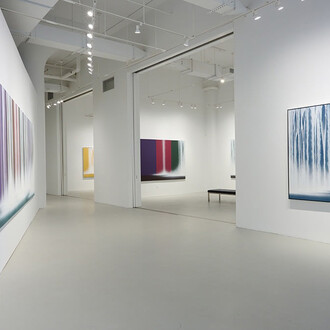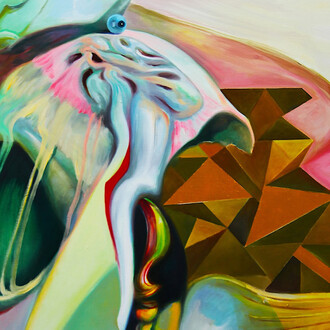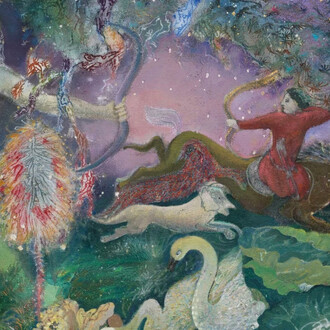Sundaram Tagore Gallery is pleased to present our annual summer group exhibition, which this year showcases new and historic paintings, photographs and sculptures by gallery artists inspired by the power and beauty of nature. In both abstract and literal ways, each artist uniquely expands beyond the limits of the empirical realm to transport viewers to an imagined reality.
New York-based artist Miya Ando (b. 1973, Los Angeles) is widely known for her expansive series of cloud paintings, which are rooted in the Japanese concept mono no aware. The phrase, which loosely translates as “an acute awareness of the transience of things”, is a sentiment often linked to nature and the passage of time. “The paintings invite viewers to consider an alternative perspective—to become aware of and to appreciate the present moment”, says Ando.
Ando’s work is in the collections of the Los Angeles County Museum of Art; Corning Museum of Glass, New York; Detroit Institute of Arts, Michigan; Scottsdale Museum of Contemporary Art, Arizona; Santa Barbara Museum of Art, California; as well as numerous private collections.
The work of Nigerian-American artist Osi Audu focuses on the dualism of form and void, the tangible and intangible. Using a variety of mediums, including acrylic, graphite, pastel and wool on canvas or paper, he examines scientific, philosophical and cultural concepts surrounding the relationship between mind and body. His compositions are often inspired by the abstract geometric possibilities he sees in African art and cultural objects and the concept of the head as a center of waking and dreaming consciousness.
Audu received his undergraduate degree in fine arts from the University of Ife, Ife-Ife, Nigeria, and his master’s degree at the University of Georgia in the United States. He has exhibited his work at the Smithsonian National Museum of African Art, Washington, D.C.; National Gallery of Modern Art and Franco-German Gallery, Lagos, Nigeria; Skoto Gallery and Bonhams, New York; the Africa Centre, the Science Museum and the British Museum, London; and the Tobu Museum of Art, Tokyo, among others. His work was in the first Gwangju Biennale in 1995 and in 2015, two of his paintings were included in Frontiers Reimagined, a Collateral Event of the 56th Venice Biennale. Currently, Adau’s work is on view in an ongoing exhibition at the Newark Museum of Art and the United States Ambassador’s Residence in Abuja, Nigeria, as part of the U.S. Department of State’s Art in Embassies Program.
Acclaimed Canadian photographer Edward Burtynsky (b. 1955) chronicles the human impact on nature in disarmingly beautiful images of natural and industrial landscapes around the globe. Shot from up to 7,000 feet above, Burtynsky’s painterly, often abstract images bring the scale of environmental devastation into perspective.
Burtynsky: abstraction/extraction, the largest exhibition of his work to date, is on view at Saatchi Gallery, London, until May 6, 2024. Notable exhibitions include Anthropocene (2018) at the Art Gallery of Ontario and the National Gallery of Canada (international touring exhibition); Water (2013) at the New Orleans Museum of Art and Contemporary Arts Center, Louisiana (international touring exhibition); Oil (2009) at the Corcoran Gallery of Art in Washington, D.C. (five-year international touring show), China (toured 2005 – 2008); Manufactured Landscapes at the National Gallery of Canada (toured 2003 – 2005); and Breaking ground produced by the Canadian Museum of Contemporary Photography (toured 1988 – 1992).
Korean artist Chun Kwang Young incorporates elements of both painting and sculpture in his practice. He is best known for his acclaimed Aggregation series: freestanding and wall-hung amalgamations of small, triangular forms wrapped in antique mulberry paper, often tinted with teas or pigment.
Chun Kwang Young received a Bachelor of Fine Arts degree from Hongik University, Seoul and a Master of Fine Arts from the Philadelphia College of Art, Pennsylvania. His work is in numerous public collections, including the British Museum and the Victoria and Albert Museum, London; The Rockefeller Foundation and the United Nations, New York; the Woodrow Wilson International Center for Scholars, Washington, D.C.; the Philadelphia Society Building, Pennsylvania; the National Museum of Modern and Contemporary Art, Seoul, and the Seoul Museum of Art; the National Gallery of Australia, Canberra; and the National Museum of Fine Arts, Malta.
He was named Artist of the Year by the National Museum of Modern and Contemporary Art, Seoul, in 2001, and in 2009 he was awarded the Presidential Prize in the 41st Korean Culture and Art Prize by the Ministry of Culture, Sports and Tourism.
Golnaz Fathi (b. 1972) is part of a thriving generation of Iranian artists who grew up during the Islamic revolution and the Iran-Iraq war, a deeply isolated period of the country’s history. Fathi is one of the few women in Iran to excel at traditional calligraphy. Fascinated by the expressive nature of calligraphic forms, she spent years rigorously training up to eight hours daily, learning to control her breathing and writing poetry with a qalam to master traditional strokes.
Fathi’s works are in the permanent collections of The Metropolitan Museum of Art, New York, which in 2019 featured her work in the exhibition The Decorated Word: Writing and Picturing in Islamic Calligraphy; The British Museum, London; Denver Art Museum, Colorado; Asian Civilisations Museum, Singapore; Islamic Arts Museum Malaysia, Kuala Lumpur; Museum of Contemporary Art, CAA, Hangzhou, China; World Bank, Washington, D.C.; Brighton & Hove Museums, England; Carnegie Mellon University, Doha; Devi Art Foundation, New Delhi; The Farjam Collection, Dubai. In 2015, her work was exhibited in Frontiers Reimagined at the 56th Venice Biennale.
Golnaz Fathi has been recognized with numerous awards and accolades. In 1995, she was named Best Woman Calligraphist by the Iranian Society of Calligraphy. In 2010, she was invited to be a member of the selection committee of the renowned Sharjah Calligraphy Biennial and in the following year was chosen as a Young Global Leader Honoree by the World Economic Forum.
The artworks of Hock E Aye Vi Edgar Heap of Birds include multi-disciplinary forms of Public Art Messages, Large Scale Drawings, Neuf Series Acrylic Paintings, Prints, Works in Glass, and Monumental Porcelain Enamel on Steel Outdoor Sculpture.
Heap of Birds’ Artistic Creations and Efforts as an Advocate for Indigenous Communities Worldwide are focused first upon Social Justice and then the Personal Freedom to live within the Tribal Circle as an Expressive Individual.
American/British artist Karen Knorr (b. 1954, Germany) creates sumptuous photographs that employ opulent architectural settings in Western Europe and Asia to frame issues of power rooted in cultural heritage. Knorr digitally imposes images of tigers, elephants, peacocks and monkeys, which she photographs in reserves and zoos, within these lavish spaces. The settings are symbolic of wealth and social hierarchies and the animals who wander through them disrupt and disturb the power dynamics.
Knorr’s work is in the collections of Tate London, Victoria & Albert Museum and United Kingdom Government Art Collection, London; Centre Pompidou, Paris; Moderna Museet, Stockholm; San Francisco Museum of Modern Art, California; and The National Museum of Modern Art, Kyoto, Japan, among others.
Ricardo Mazal (b. 1950, Mexico City), one of Mexico’s most prominent contemporary artists, is known for his lush abstract oil paintings in which he explores spiritual themes.
Ricardo Mazal has exhibited extensively in museums and galleries throughout the Americas, Asia and Europe. Since 2000, he has had five museum retrospectives: Museo de Arte Contemporáneo de Monterrey (2000); Museo de Arte Moderno, Mexico City (2006); Museo de Arte, Querétaro, Mexico (2009); Museo de Arte Abstracto Manuel Felguérez, Zacatecas, Mexico (2010); and the Center for Contemporary Arts Santa Fe (2018). His work has been featured in solo exhibitions at the Center for Contemporary Arts, Santa Fe (2002 and 2004); Museo Nacional de Antropología, Mexico City (2004–2005); Scottsdale Museum of Contemporary Art (2006); Centro de las Artes, Monterrey, Mexico (2006); the Mexican Cultural Institute, Washington, DC (2008); and the Centro Cultural Estación Indianilla, Mexico City (2012, 2015, 2017 and 2020). His work was also showcased in group exhibitions at the NTU Centre for Contemporary Art Singapore (2016); and Frontiers Reimagined at the 56th Venice Biennale (2015).
Mazal’s work is included in the permanent collections of the Minneapolis Institute of Art, Minnesota; Scottsdale Museum of Contemporary Art, Arizona; Museo de Arte Moderno, Mexico City; Museo de Arte Abstracto Manuel Felguérez, Zacatecas, Mexico; Fondation Maeght, Paris; Centro de las Artes, Monterrey, Mexico; Cirque du Soleil, Montreal; The Peninsula Hotel, Shanghai; and Deutsche Bank, New York and Germany.
Celebrated as an unsurpassed colorist and for the beauty of his large-scale abstract works, Robert Natkin (1930–2010) was a Chicago-born artist associated with the Color Field and Lyrical Abstraction painters. His hues are shamelessly seductive, whether deployed in vertical columns in his Apollo paintings, spread in gauzy veils in his Bath series, or strikingly textured in the Bern pictures. On his canvases, paint creates a seemingly infinite space in which iconographic details appear to hover or float through illusory depths.
Natkin’s work can be found in the collections of The Museum of Modern Art, Brooklyn Museum, Solomon R. Guggenheim Museum, and Whitney Museum of American Art, New York; the Los Angeles County Museum of Art; the Hirshhorn Museum and Sculpture Garden, Washington, DC; the Museum of Fine Arts, Houston; the Art Institute of Chicago; and the Centre Pompidou, Paris, among others.
Kenny Nguyen (b. 1990, Ben Tre Province, Vietnam) creates expansive, dimensional, mixed-media paintings that center on ideas of cultural identity, displacement and integration. Nguyen grew up on a coconut farm in a rural area near the Mekong Delta in southern Vietnam. Despite having an established career in fashion design, he decided to join his family when they moved to the United States in 2010.
Nguyen has participated in exhibitions across the globe, including at the Sejong Museum of Art, Seoul; CICA Museum (Czong Institute for Contemporary Art), Gimpo, Gyeonggi Province, Korea; Kunstwerk Carlshütte, Büdelsdorf, Germany; LaGrange Art Museum, Georgia; Museum of Contemporary Art Jacksonville, Florida; Orange County Center for Contemporary Art, Santa Ana, California; and The Rayburn House Office Building, United States Capitol Complex, Washington, DC. In 2016, Nguyen received the Excellence Asia Contemporary Young Artist Award from Sejong Museum of Art and in 2023, a nomination for the Joan Mitchell Fellowship. He has been awarded numerous grants, fellowships and residencies.
Udo Nöger creates luminous monochrome paintings that capture light, movement and energy expressed in highly minimalistic compositions.
Udo Nöger has exhibited extensively across the globe, including at Siegerlandmuseum, Siegen, and the Karl Ernst Osthaus-Museum, Hagen, Germany; Daum Museum of Contemporary Art, Sedalia, Missouri; Museum of Art Honolulu, Hawaii; and the Museum of Contemporary Art, Denver, Colorado. His work is in the permanent collections of The Metropolitan Museum of Art, New York; Museum of Contemporary Art, Denver; Art Institute of Chicago; Bass Museum, Miami; and Haus der Kunst, Munich, among others.
Artist, poet and Tantric guru Sohan Qadri (1932-2011) is one of the only internationally acclaimed artists deeply engaged with spirituality. Qadri abandoned representation early on in his long career, incorporating Tantric symbolism and philosophy into his vibrantly colored minimalist works. Born in India, he was initiated into yogic practice at age seven. In 1965, he left India and began a series of travels that took him to East Africa, North America, Paris and Zurich.
Sohan Qadri’s works are included in numerous museum collections, including those of The British Museum, London; the Brooklyn Museum and The Rubin Museum of Art, New York; the Los Angeles County Museum of Art, California; the Peabody Essex Museum, Massachusetts; the Royal Ontario Museum, Toronto; and the National Gallery of Modern Art, New Delhi as well as the private collections of Cirque du Soleil, Heinrich Böll and Dr. Robert Thurman. creates luminous monochrome paintings that capture light, movement and energy expressed in highly minimalistic compositions.
Sebastião Salgado (b. 1944) is a Brazilian-born photographer and artist-activist based in Paris. He has made it his life’s work to document the impact of globalization on humankind. His hauntingly beautiful black-and-white prints lay bare some of the bleakest moments of modern history, telling the story of Vietnamese boat people, Rwandan refugees, Indian coffee growers, and countless other impoverished individuals. For his most recent project, Amazonia, he spent six years in Brazil’s Amazon photographing its landscape and people.
Salgado has had numerous exhibitions in major museums across the globe. Among his many honors, Salgado has been named a UNICEF Goodwill Ambassador and an honorary member of the Academy of the Arts and Sciences in the United States. He has twice been named photographer of the year by the International Center of Photography and in 2019 he was the first photographer honored with the Peace Prize of the German Book Trade. Most recently, the World Economic Forum announced Salgado as the 2021 winner of the 27th Annual Crystal Award for his leadership in addressing inequality and sustainability.
New York-based painter Hiroshi Senju (b. 1958, Tokyo) is renowned worldwide for his sublime waterfall and cliff images, which are often monumental in scale. He combines a minimalist visual language rooted in Abstract Expressionism with elements of traditional Japanese painting.
Hiroshi Senju was the first Asian artist to receive an Honorable Mention Award at the Venice Biennale (1995), and has participated in numerous notable exhibitions including The new way of tea, curated by Alexandra Munroe, at the Japan Society and Asia Society, New York, 2002; Paintings on Fusuma at the Tokyo National Museum, 2003; and Frontiers reimagined at the Venice Biennale, 2015. In 2021, Senju produced a monumental, site-specific fluorescent waterfall installation for the Art Institute of Chicago. It was on view for eight months in a gallery in the Asian wing designed by Pritzker Prize-winning architect Tadao Ando. The fifty-foot wide folding screens are now part of the museum’s permanent collection. In 2023 two specially commissioned waterfall paintings were installed in the United States Embassy in Tokyo. A waterfall painting is currently on view in the Victoria & Albert Museum in London.
Senju’s work is in the permanent collections of the Victoria & Albert Museum, London; The Metropolitan Museum of Art and Brooklyn Museum, New York; Los Angeles County Museum of Art and Museum of Contemporary Art, Los Angeles; Asian Art Museum, San Francisco; Nelson-Atkins Museum of Art, Kansas City, Missouri; Royal Ontario Museum, Toronto; Museum of Modern Art, Toyama, Japan; Yamatane Museum of Art, Tokyo; Tokyo University of the Arts; and Kushiro Art Museum, Hokkaido. In 2009, Skira Editore published a monograph of his work titled Hiroshi Senju. The Hiroshi Senju Museum Karuizawa in Japan opened in 2011.
Joan Vennum (1930–2021) was a New York-based artist who created luminous, color-flooded paintings that explore spatial environments. They are at once abstract and figurative. Best known for her ethereal canvases of repeated layers and gradations of color fields, Vennum's roots were in post-abstract expressionism and she portrayed the illusion of limitless space, as it appeared both in her imagination and in the natural world.
Joan Vennum’s work is in the permanent collections of the Brooklyn Museum, New York; The Power Collection of Contemporary Art, Sydney, Australia; the Konstmuseet, Uttersberg, Sweden; the Skandia Försäkringsbolag, Stockholm; and the Museo Civico, Taverna, Italy.
Robert Yasuda (b. 1940, Hawaii) is known for luminous multi-panel works composed of translucent, veil-like fields of color layered on slabs of wood that protrude from the wall or nestle into corners. Depending on where you stand, the surfaces of the paintings shift in color and temperature. Yasuda invites viewers to pause and immerse themselves in the work in order to perceive these subtle transformations revealed over time.
Yasuda has been recognized with awards from the National Endowment for the Arts and the American Academy of Arts and Letters. His works are in the permanent collections of the Brooklyn Museum, New York; Library of Congress, Washington, DC; The New York Public Library; Carnegie Institute, Pittsburgh; and The McNay Art Museum, San Antonio, Texas.
Beijing-based sculptor Zheng Lu (b. 1978, Chifeng, Inner Mongolia) skillfully merges concepts rooted in Chinese philosophy and elements of the natural world with material explorations that push the boundaries of physical form. Zheng is best known for his Water in Dripping series of dynamic stainless-steel compositions evoking splashes of water suspended midair. “Water is a very important motif in my art”, he says. “As a key element in Chinese philosophy, it was observed, visualized and ruminated upon rather than examined in terms of logic”.
Zheng’s large-scale installations have been exhibited in museums and public spaces around the world, including, most recently, a gleaming twenty-foot-tall steel sculpture installed adjacent to the United Nations complex in midtown Manhattan.
















